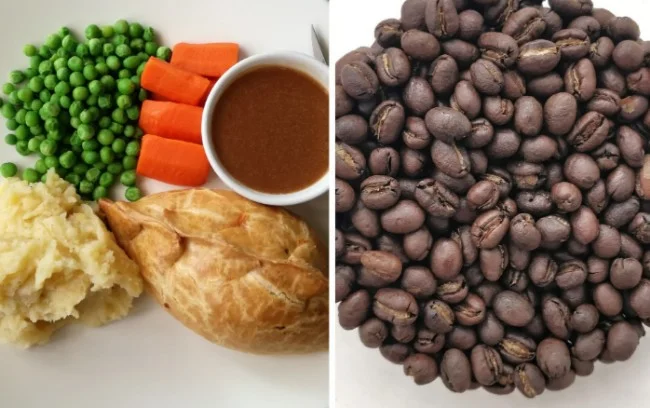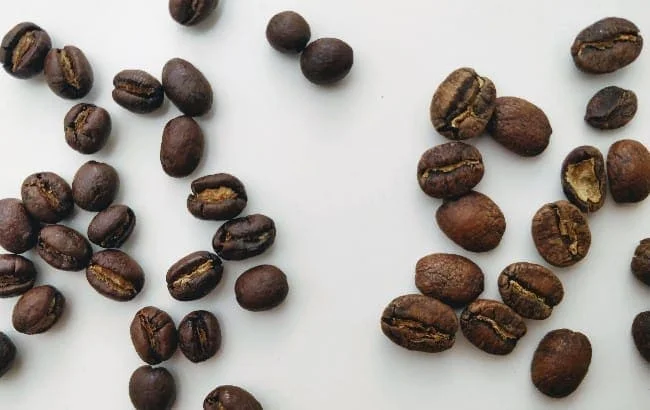Peaberry coffee is an intriguing variety. It shares an air of mystery with beans like Kona and Blue Mountain. While specialty coffee and the third wave have established a range of new heroes such as Geisha and Pacamara, peaberry is more old school.
That’s not to say that peaberry is bad in any way. It’s just not as trendy as it once was. It’s reminiscent of the gastronomy world: In the 70s, people were enamored with quiche and fondue, while today, the obsessions are avocado toast and smoothie bowls.
With that out of the way, let’s take a closer look at what’s so exciting about this bean.

What is a peaberry?
As you probably know, coffee is a fruit. What we call beans are actually seeds that are contained inside a cherry. Typically there are two seeds, and because they are resting against each other, they have a flat bottom and a more rounded side.
The peaberry is a freak of nature. Sometimes the coffee cherry will develop with only one seed inside. Because they don’t have any twin to put pressure on the side, they get a rounded shape that is reminiscent of a pea or a berry — hence the name.
This phenomenon occurs when only one or two of the ovaries in the coffee flower are pollinated. So the peaberry is not ideal; it’s not Mother nature’s ideal.
In general, when organisms have fertility problems, we don’t see it as a sign of superior quality, and perhaps the same rule should apply to coffee.
However, for many years, peaberry coffee has been promoted as being somewhat superior to regular coffee.
Peaberries occur naturally in 5 to 10 percent of coffee. However, when arabica is crossed with robusta, that number goes up because of the infertility issues mentioned before.
If you’re curious about visiting a real coffee farm, then check out this video! It’s easier than you think 👇
Is peaberry better than regular coffee?
Back in the day, coffee salesmen would sing the praises of peaberry. The argument was that it was somehow a more concentrated bean because it doesn’t have to share nutrients with another seed.
Today, the consensus in the coffee industry seems to be that peaberry is neither worse or better; it’s just different.
With coffee, there are so many factors that play into the final product. Altitude, varietal, soil, and farming skills all have more to say than whether the coffee is peaberry or a flat berry (normal bean).
Let’s take an example:
- Is a peaberry of the catimor varietal grown at 800 masl in Indonesia better than a regular Ethiopian Yirgacheffe grown at 1700 masl?
The answer is a resounding “no.” I’ll bet my old hat that the Ethiopian bean will be sweeter, cleaner, and more interesting than the Indonesian peaberry every day of the week.
To say that a peaberry is somehow better than regular coffee doesn’t make any sense. People who claim that inadvertently show that they don’t understand the multitude of factors that go into cup quality (it’s the same kind of people that praise kopi luwak).
How is peaberry coffee made
If you buy a bag of unroasted coffee beans, there’s a good chance that you’ll find a few peaberries in the mix.
However, many coffee producers tend to sort out the peaberries and sell them separately.
You have probably already heard about Kenyan AA and AB. This categorization doesn’t say anything about quality. It’s just two different bean sizes.
All decent coffee mills will try to separate the coffee beans by size, and in the same process, you’ll get a portion of peaberries.
The main reasons to separate the beans by size isn’t because smaller or larger is better. Instead, it’s to make roasting easier. If there are too many different sizes in a batch, they will develop at different rates. The small bean will get dark and roasty while the bigger bean will taste grassy and sour. So the more consistent the bean size is, the easier the job is for the roastmaster.
Peaberries tend to roast very evenly. Because they are small and round, the heat transfers more reliably than regular coffee beans.
Tanzania Peaberry
Peaberry and Tanzania have somehow become firmly related, which is kind of strange. You have peaberry everywhere in the world, and you also have excellent regular coffee from Tanzania. So why this combo?
The most likely explanation is due to random historical circumstances. Japanese coffee buyers have a thing for Tanzanian coffee, and so they would buy the vast majority. The peaberry was the leftover coffee that found a niche as a curiosity in the American market.
Back then, the coffee marketing jargon was closely related to each coffee origin, having some ‘superpower’ that defined them. Just think of:
Somehow ‘regular Tanzania’ doesn’t fit into that mold. But Peaberry Tanzania, on the other hand… that stuff is easy to sell.
The industry expert Kenneth Davids from Coffee Review has also been puzzled by this weird connection. He arrived at a similar conclusion.
“Frankly, I don’t have a clue and neither does anyone else I have contacted. None of the statistics I have seen suggest that Tanzania produces any more peaberry than does any other coffee region. I would guess that at some early date in the development of specialty coffee the association of Tanzania and peaberry was established, and the combination remained standard in the specialty repertory ever since.” (source)
The truth is that there is nothing inherently Tanzanian about this kind of coffee. The coffee plant doesn’t know about land borders (only humans do), and there are peaberries everywhere coffee is grown.
Conclusion: Should you try it?
I think most coffee lovers are adventurous people deep down. We crave novelty, and we want to try the rare and the exquisite. Those reasons might be enough for you to try to get your hands on some peaberry beans.
Personally, I think it’s worth trying peaberry coffee at least once to see if you appreciate the subtle differences it may offer compared to regular beans. However, don’t expect a groundbreaking experience. The difference will likely be more about the novelty than any drastic improvement in taste.
In the end, the factors that have the most significant impact on your coffee’s flavor are the origin, varietal, processing method, and roasting profile. Peaberry beans can offer a slightly different experience, but the difference might not be enough to become a die-hard fan.
So, if you’re curious, go ahead and give peaberry coffee a try. Just remember to focus on the other essential factors that contribute to great-tasting coffee. And who knows? You might discover a new favorite or, at the very least, enjoy the exploration of this unique and interesting coffee bean.
FAQ
Sometimes the coffee cherry will develop with only one seed inside. Because they don’t have any twin to put pressure on the side, they get a rounded shape that is reminiscent of a pea or a berry — hence the name.
Today, the consensus in the coffee industry seems to be that peaberry is neither worse or better; it’s just different. With coffee, there are so many factors that play into the final product. Altitude, varietal, soil, and farming skills all have more to say than whether the coffee is peaberry or a flat berry (normal bean).
No, peaberry coffee has the same level of caffeine when contrasted and other Arabica espresso beans whose caffeine content generally averages about 1.2%
